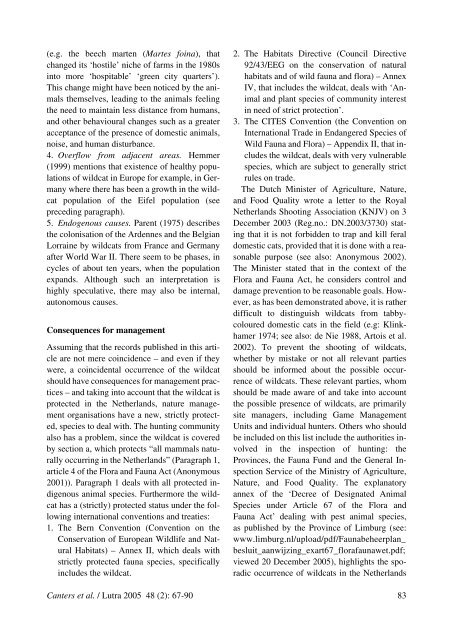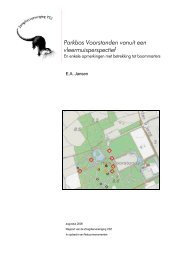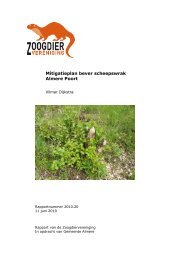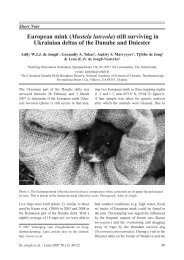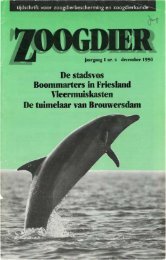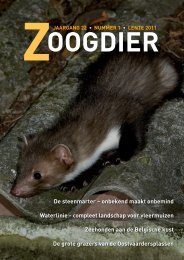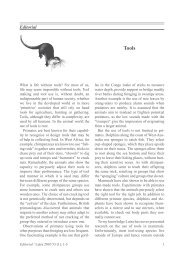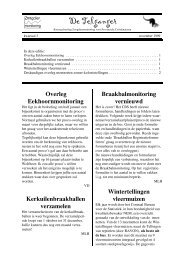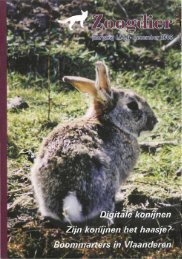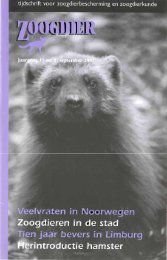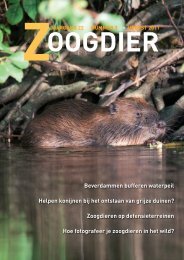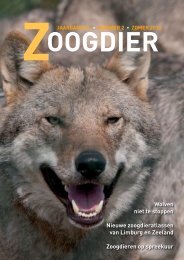binnenwerk 48-2-2005 - De Zoogdiervereniging
binnenwerk 48-2-2005 - De Zoogdiervereniging
binnenwerk 48-2-2005 - De Zoogdiervereniging
You also want an ePaper? Increase the reach of your titles
YUMPU automatically turns print PDFs into web optimized ePapers that Google loves.
(e.g. the beech marten (Martes foina), thatchanged its ‘hostile’ niche of farms in the 1980sinto more ‘hospitable’ ‘green city quarters’).This change might have been noticed by the animalsthemselves, leading to the animals feelingthe need to maintain less distance from humans,and other behavioural changes such as a greateracceptance of the presence of domestic animals,noise, and human disturbance.4. Overflow from adjacent areas. Hemmer(1999) mentions that existence of healthy populationsof wildcat in Europe for example, in Germanywhere there has been a growth in the wildcatpopulation of the Eifel population (seepreceding paragraph).5. Endogenous causes. Parent (1975) describesthe colonisation of the Ardennes and the BelgianLorraine by wildcats from France and Germanyafter World War II. There seem to be phases, incycles of about ten years, when the populationexpands. Although such an interpretation ishighly speculative, there may also be internal,autonomous causes.Consequences for managementAssuming that the records published in this articleare not mere coincidence – and even if theywere, a coincidental occurrence of the wildcatshould have consequences for management practices– and taking into account that the wildcat isprotected in the Netherlands, nature managementorganisations have a new, strictly protected,species to deal with. The hunting communityalso has a problem, since the wildcat is coveredby section a, which protects “all mammals naturallyoccurring in the Netherlands” (Paragraph 1,article 4 of the Flora and Fauna Act (Anonymous2001)). Paragraph 1 deals with all protected indigenousanimal species. Furthermore the wildcathas a (strictly) protected status under the followinginternational conventions and treaties:1. The Bern Convention (Convention on theConservation of European Wildlife and NaturalHabitats) – Annex II, which deals withstrictly protected fauna species, specificallyincludes the wildcat.2. The Habitats Directive (Council Directive92/43/EEG on the conservation of naturalhabitats and of wild fauna and flora) – AnnexIV, that includes the wildcat, deals with ‘Animaland plant species of community interestin need of strict protection’.3. The CITES Convention (the Convention onInternational Trade in Endangered Species ofWild Fauna and Flora) – Appendix II, that includesthe wildcat, deals with very vulnerablespecies, which are subject to generally strictrules on trade.The Dutch Minister of Agriculture, Nature,and Food Quality wrote a letter to the RoyalNetherlands Shooting Association (KNJV) on 3<strong>De</strong>cember 2003 (Reg.no.: DN.2003/3730) statingthat it is not forbidden to trap and kill feraldomestic cats, provided that it is done with a reasonablepurpose (see also: Anonymous 2002).The Minister stated that in the context of theFlora and Fauna Act, he considers control anddamage prevention to be reasonable goals. However,as has been demonstrated above, it is ratherdifficult to distinguish wildcats from tabbycoloureddomestic cats in the field (e.g: Klinkhamer1974; see also: de Nie 1988, Artois et al.2002). To prevent the shooting of wildcats,whether by mistake or not all relevant partiesshould be informed about the possible occurrenceof wildcats. These relevant parties, whomshould be made aware of and take into accountthe possible presence of wildcats, are primarilysite managers, including Game ManagementUnits and individual hunters. Others who shouldbe included on this list include the authorities involvedin the inspection of hunting: theProvinces, the Fauna Fund and the General InspectionService of the Ministry of Agriculture,Nature, and Food Quality. The explanatoryannex of the ‘<strong>De</strong>cree of <strong>De</strong>signated AnimalSpecies under Article 67 of the Flora andFauna Act’ dealing with pest animal species,as published by the Province of Limburg (see:www.limburg.nl/upload/pdf/Faunabeheerplan_besluit_aanwijzing_exart67_florafaunawet.pdf;viewed 20 <strong>De</strong>cember <strong>2005</strong>), highlights the sporadicoccurrence of wildcats in the NetherlandsCanters et al. / Lutra <strong>2005</strong> <strong>48</strong> (2): 67-90 83


